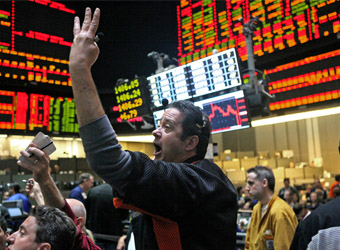U.S. equities closed mixed on Friday after the initial fourth-quarter GDP read fell short of estimates, but managed to record weekly gains of around 1 percent.
The Dow Jones industrial average slipped 10 points but held above 20,000, with Chevron and Goldman Sachs contributing the most losses. Chevron shares declined after the firm reported disappointing quarterly results.
The Energy Select Sector SPDR Fund ETF (XLE) fell 1 percent. Also weighing energy stocks were falling crude prices, with WTI dropping 1.13 percent to settle at $53.17 a barrel.
The S&P 500 slipped 0.1 percent, with real estate and energy leading decliners, while the Nasdaq composite closed 0.1 percent higher.
“The market probably got a bit ahead of itself with all these proposed changes from the new administration,” said Sean O’Hara, president of Pacer ETF Distributors. “The results have to match the expectations.”
The three major large-cap indexes hit record highs earlier in the week.
Economic growth in the U.S. slowed more than expected in the fourth quarter as a plunge in shipments of soybeans weighed on exports, but steady consumer spending and rising business investment suggested the economy would continue to expand.
Gross domestic product increased at a 1.9 percent annual rate, the Commerce Department said on Friday in its first estimate of fourth-quarter GDP. That was a sharp deceleration from the 3.5 percent growth pace logged in the third quarter.
“The year ends on a mediocre fashion but policy is about to change,” Peter Boockvar, chief market analyst at The Lindsey Group, said in a note.
“Positively on the fiscal side and a drag on the monetary side, so we can consider Q4 data old news but it does set the stage and baseline for 2017.” Boockvar also said.
Other economic data reported Friday included durable goods orders, which fell 0.4 percent in December, and consumer sentiment for January, which hit 98.5, above an estimate of 98.1.
“The GDP confirms what we already knew. The U.S. economy is stuck in this growth range,” said Michael Arone, chief investment strategist at State Street Global Advisors. The market “is looking forward to fiscal policy boosting this economy.”
Equities have rallied sharply since President Donald Trump’s election victory on Nov. 8, as the prospects of higher fiscal spending, corporate tax cuts and deregulation grew.
“Many of these proposals are market friendly. We don’t dismiss that,” said Stephen Wood, chief market strategist at Russell Investments.
He added, however, the market has already priced in many of these measures becoming law, leaving the market vulnerable to a downside surprise.
Trump, who was sworn in last week, has signed a series of executive orders on matters ranging from immigration to infrastructure spending. He met with UK Prime Minister Theresa May.
In a news conference following the meeting, May said Ukraine-related sanctions on Russia should remain, while Trump said it is too early to tell.
Ahead of the meeting, Naeem Aslam, chief market analyst at Think Markets, said the meeting was “very important for both individuals because they are labeled as anti-free trade and driving the engine of populism and protectionism.”
U.S. dollar traded about 0.2 percent higher against a basket of currencies, with the euro holding near $1.069 and the yen around 115.1.
However, the greenback, one of the biggest winners since the election, has eased more than 1.5 percent this month, as investors look for more clarity on the new administration’s policies.
“The long dollar trade from the end of last year has been a bit of a wash recently, said Peter Ng, senior FX trader at Silicon Valley Bank. A lot of people “are still on the sidelines.”
In corporate news, earnings season continued, with Colgate-Palmolive, American Airlines Group, AbbVie and General Dynamics all reporting before the bell. Tech giants Alphabet, Microsoft and Intel all reported after the close on Thursday.
Overseas, European equities fell, with the pan-European Stoxx 600 index dropping 0.3 percent, as a global stocks rally paused.
Stocks in Europe have lagged their U.S. counterparts over the past year. However, State Street’s Arone said they may be ripe for a surprise to the upside this year.
” Investors are wary of taking positions in Europe, but the underlying data is improving,” he said.
The Dow Jones industrial average fell 7.13 points, or 0.04 percent, to close at 20,093.78, with Chevron leading decliners and Microsoft the biggest advancer.
The S&P 500 slipped 1.99 points, or 0.09 percent, to 2,294.69, with real estate leading eight sectors lower and health care outperforming.
The Nasdaq composite 5.61 points, or 0.1 percent, to 5,660.78.
About four stocks declined for every three advancers at the New York Stock Exchange, with an exchange volume of 750.9 million and a composite volume of 3.124 billion.
The CBOE Volatility Index (VIX), widely considered the best gauge of fear in the market, traded near 10.5.
According to TABB Group, high-frequency trading accounted for 52 percent of January’s daily trading volume of about 6.75 billion shares.
During the peak levels of high-frequency trading in 2009, about 61 percent of 9.8 billion of average daily shares traded were executed by high-frequency traders.
Source: CNBC
